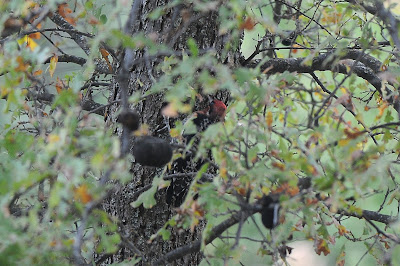You may have forgotten that I occasionally write reviews on this blog about new books published by Princeton Press. Hopefully this reminds you!
"Birds of North America and Greenland", by Norman Arlott, was published in 2011 by Princeton University Press.
This book is in the Princeton Illustrated Checklist series and I actually reviewed a book in the same series back in July. Click
here to go to that post.
This is an interesting book for several reasons. I ended up learning a lot of things I had never seen in any of the other, more popular bird books I use. That surprised me. More on that in a bit...
I think it's clear that this book is intended for those interested in birds here in North America and Greenland but for those who aren't interested in getting down to the details that make some of the other popular bird books so bulky. What about a traveling birder who needs a small and compact guide? This might be perfect. Yes, this book is small which I actually like. It is 239 pages but feels much thinner to me. Compared to the Sibley Guide, it looks like a midget:
Here is a typical view when you open the guide:
I'll be honest, the first thing I noticed was, "Wait, are there no range maps?". I even flipped to the back of the book looking to see if the maps were separate. Turns out, you'll see the microscopic range maps when you REALLY open the book, as you can see below:
For me, visual references of range and distribution mean a lot. The range maps in this book just aren't meant to be a main feature; there is very little detail. Sure, I guess you could confirm that Ross's Gulls don't occur in Texas; and that really might be all that's needed for a visiting birder who just don't know the birds here very well. In the end, I'm ok with this guide not having better quality range maps but I would have loved to see more detail go into those.
A typical 2-page spread has anywhere from 5-12 species represented. The text and range map are found on the left and the illustrations of the birds are found on the right. The text includes basic information such as common name, scientific name, size (in centimeters), and some brief field notes, voice information, habitat, and distribution.
I was surprised by the alternate names that the author put alongside the common names. Many of them I had never heard of. Sure, I knew that Red Phalarope is also known as Grey Phalarope. However, I had no clue that Black Guillemot is also known as a "Tystie"! Here are some examples of alternate names that I hadn't heard of before:
Gray Flycatcher = Wright's Flycatcher
Common Myna = Indian Myna
Slate-throated Redstart = White-throated Whitestart
White-winged Crossbill = Two-barred Crossbill
Snail Kite = Everglade Kite
Spectacled Eider = Fischer's Eider
Horned Lark = Shore Lark
One of the aspects that I like the most is that the book contains every species that is on the ABA list. The only other book that I've seen do this is the new National Geographic guide. You can open it up to page 100 and see that Large-billed and Whiskered tern are indeed on the ABA list. This book goes a step further and even includes species from Greenland. Open it up to page 166 and see that Blackcap has actually been recorded from Greenland. Cool, right?
The art seems to be pretty consistant. Although I've seen art in books much much worse, something about a couple of the plates really throws me off. The vireos, for example, look way more confusing to me in this book than any other book. Similarly, the hummingbirds and hawks somehow become really confusing in this guide. Look at the flycatchers and you can just forget it.
For those who know me pretty well, you know that I'm a stickler of small details like bird codes and names. It pains my ears to hear people say things like "There's a Ross Goose" or "Is that a Cassin Sparrow singing?". Well, now I know why people say things like that... because it's typed that way in a book! Yes, page 60 shows a species by the name of "Harris Hawk". Ouch. However, they got it right later in the book with "Harris's Sparrow".
So will this book rival the Sibley Guide to Birds or the new National Geographic Guide to Birds? Well, not in my opinion but I'm wondering if that's not such a bad thing. If a child picks this book up someday and that's enough for him/her to become interested in birds, it's totally worth it.
Disclaimer:
I received a complementary copy from the publisher for review purposes,
but the viewpoint expressed in this article is entirely my own.


















































